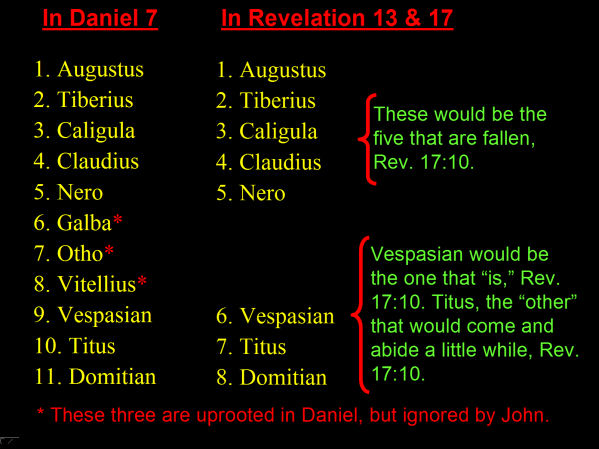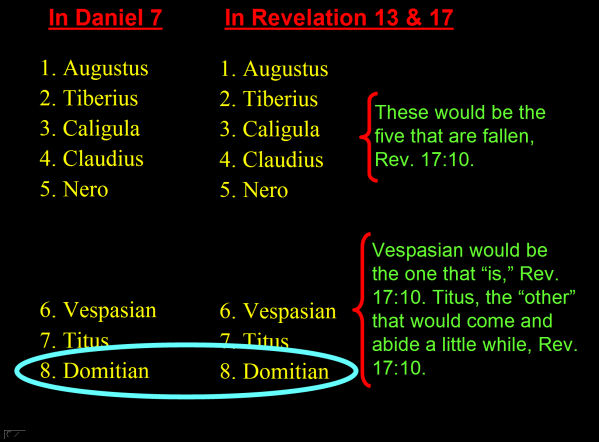The Time Factor (Part II)
If Vespasian is the emperor of Rome when John is receiving and communicating this revelation, and I believe the material we covered in the last article indicates he was, then the date for this book falls somewhere between 69-79. This makes it too early for the reign of Domitian (81-96), which the traditional late daters favor—with the general consensus of these folks for the distribution of this revelation closer to 96. At the same time, 69-79 is too late for the early daters/REs, for they believe the book was probably written around 67-68. Although 69-79 is thought too late to fit the early daters/REs timeframe for the writing of Revelation, there is still a smidgen of room for a pre-A.D. 70 date under Vespasian. So let’s examine this a bit closer, just to be sure.
Vespasian was sent by Nero in 67 to suppress the Jewish Revolt, which had started back in 66. As a result of the upheavals associated with the suicide of Nero in 68 and the short reigns of Galba, Ortho, and Vitellius (known as “the Year of the Four Emperors”), he was declared Imperator on July 1, 69. Shortly thereafter, he was recognized by his soldiers as emperor. After the defeat of Vitellius on December 10, 69 Vespasian was the very next day officially proclaimed emperor by the Roman Senate. Tacitus records that by December 22, 69, Vespasian had been given all the honors and privileges usually granted to emperors. However, he did not actually arrive in Rome until late summer, 70. In conjunction with this, Roman armies under the direction of Titus, Vespasian’s son, besieged the city of Jerusalem on April 14, 70, eventually capturing it and wreaking havoc on its inhabitants. Then, on August 10, the Temple was finally breached and set afire in the resulting melee. It, therefore, seems most unlikely that a revelation given during the reign of Vespasian which, according to the early daters/REs, was designed to foretell the destruction of Jerusalem, the Temple, and the commonwealth of Israel would have had time to be distributed before the supposed events would have occurred. Thus, it seems highly likely that the conflict being depicted in John’s Revelation was not between Jerusalem and the church, as the early daters/REs insist, but between the persecuting power of Rome and the Christians, who Nero and Domitian did, in fact, persecute.
The date I favor for the writing of Revelation is 77-78, which would have been in the latter years of Vespasian’s reign (he died on June 23, 79). After his death, Titus, his son, would be declared Emperor, which was the first time there had been a father-son succession in the history of Rome. Titus reigned for two short years (79-81). In Revelation 17:10, we were told, “There are also seven kings. Five have fallen, one is, and the other has not yet come. And when he comes, he must continue a short time.” That Titus is this seventh king who was coming but would only last for a short time is clearly seen in the charts below.

When the three who were uprooted are removed from Daniel’s list, it matches perfectly John’s list, as indicated in the following chart. Note that the main player is the eighth head of Revelation and the eighth horn of Daniel, who is, I believe, Domitian.

The Judgment Of The Beast
With this above scenario firmly entrenched in our minds, it is time to see how that in the September 18, 96 assassination of Domitian as the result of a palace conspiracy organized by court officials, we have God’s judgment of the “beast.” With this in mind, remember that back in the first article of this series, I said the book of Revelation begins and ends with clearly articulated time statements:
- "things which must shortly come to pass" (1:1),
- "for the time is near" (1:3),
- "the things which must shortly come to pass" (22:6), and
- "the time is at hand" (22:10).
As I mentioned back in that first article, I believe these time statements must be taken seriously by anyone who approaches this book with any hope of being able to properly interpret the events that are depicted in it. As I’ve tried to make as clear as I know how in the last two articles, I reject both the early and late date positions for the book of Revelation, espousing instead a “middle-date” thesis (76-78). If, as I’ve stated above, the September 18, 96 assassination of Domitian signals God’s judgment on the “beast,” then I am, with such a view, able to respect the "time is near" timeframe, seeing Rome, the "great harlot," being judged not in 476, as most late-daters think, but at the death of Domitian in 96—a span of some twenty years (76 to 96), at the most . But how can this possibly be the judgment of the “beast” under discussion in Revelation, for there can be no doubt that the Roman Empire and its persecution of Christians, which was revived under Domitian, continued on until Constantine’s Edict of Toleration in 311? Even after this, Rome continued to exist until Romulus Augustus, the last Emperor of the Western Roman Empire, was deposed on September 4, 476. It is to this issue, then, that we now turn our attention.
Notice once again the about-to-be-fulfilled expressions found in 1:1 & 3 and 22:6 & 10. Thus, whatever one does with the book, one must accept John’s time element. If not, what rule of acceptable Bible interpretation would one invoke? With this reminder, I wish to make it clear that I believe God judges Rome in the death of the eighth king of 17:7-11, which I’ve demonstrated was Domitian, who was assassinated on September 18, 96, which is within the parameters of the “must shortly take place” and “the time is near” passages referred to earlier.
When thinking about this, it is helpful to note that when dealing with the Seleucid kingdom in Daniel 8 and 11, Daniel breaks off consideration of this kingdom at the death of Antiochus IV Epiphanes, which occurred in 164 B.C., and this at a time when there were still some 15 minor Seleucid kings that would rule for another 100 years.  So here’s my point: if God’s judgment of the Seleucids could take place in His dealings with Antiochus IV (and it is clear that, as far as Daniel was concerned, the end of Antiochus was the end of the Seleucids), then God’s judgment of the Roman “beast” could very well have taken place in the destruction/death of Domitian. When you think about what I’m saying here, remember that God’s public judgment on an already rejected Jewish kingdom (I’m talking A.D. 70 here) did not mean the utter visible end of Judaistic religion, for it was dealt with once again in A.D. 135 under Hadrian and has continued to exist even until this day.
So here’s my point: if God’s judgment of the Seleucids could take place in His dealings with Antiochus IV (and it is clear that, as far as Daniel was concerned, the end of Antiochus was the end of the Seleucids), then God’s judgment of the Roman “beast” could very well have taken place in the destruction/death of Domitian. When you think about what I’m saying here, remember that God’s public judgment on an already rejected Jewish kingdom (I’m talking A.D. 70 here) did not mean the utter visible end of Judaistic religion, for it was dealt with once again in A.D. 135 under Hadrian and has continued to exist even until this day.
So, although Rome and its persecution of the saints would continue on for another 215 years after the death of Domitian, it was in his destruction (i.e., going to “perdition”, Rev.17:8 and 11) on September 18, 96 that we see God’s visible judgment of the “beast.” In other words, the one who is the 8th “horn” of Daniel and the 8th “head” of Revelation, the one who was depicted as ascending out of the “bottomless pit” (Rev. 17:8) and, therefore, a representation of Nero’s resurrection from the dead, the one who exalted himself as Dominus et Deus or “Lord and God,” the one who blasphemed the one and only true God and His people (Rev. 13:5-7), the one who was the 11th emperor in the long line of emperors beginning with Augustus, the one who is also the “8th,” is none other than the very personification of the “beast” who will go to “perdition” after his “forty-two months” reign (Rev. 13:5).
“Forty-Two Months,” “Times, Time, and Half A Time,” Or “One Thousand Two Hundred And Sixty Days”
And what do these forty-two months represent? Well, after such a build-up, the “beast” might be expected to last forever. But not so, praise God, for unmistakably these “forty-two months” portray a divine limitation imposed on the powerful, arrogant, and blasphemous persecutor of God’s people. In this connection, it is necessary to know that the Jews, along with other ancients, used a 360-day year with 30 days assigned to each of the 12 months of this year. Periodically, they added to this 360-day year “intercalary” months to work things out in accordance with the 365-day solar year. Under such a system, 42 months would be equivalent to 1260 days, or 3½ years (viz., “times” [2 years], “time” [1 year], and “half a time” [½ year]). This period of time, in one form or another, is found five times in Revelation and Daniel:
- It is the period of the beast’s authority—Rev. 13:5.
- It is the period of the holy city being trodden under foot—Rev. 11:2.
- It is the period between which the two witnesses prophesy—Rev. 11:3.
- It is the period the Woman is nourished in the wilderness—Rev. 12:6, 14.
- It is the period the “little horn” persecutes the saints—Daniel 7:25.
So, once again, what does this period of time signify? Remember, we’re talking about a book of symbols. And it’s not, as the so-called “literalists” claim, that we think such symbols mean nothing real. Absolutely not! The symbols mean something real. At issue is always, “What does this symbol mean?” In this case, it speaks of a state of affairs or circumstances in which God’s holy people, the saints of the Most High God, are subjected to persecution, but are protected; subjected to suffering, but are sustained; victimized, but vindicated. These two contrasting circumstances (viz., suffering, but sustained; persecuted, but protected) are always juxtaposed. In Daniel 7:25, we are told the “little horn” has power over the saints for “times, time, and half a time,” or 3½ years. But, and thank God for this “but,” his dominion shall be taken away. Verses 26-27 speak of the vindication of the kingdom of God and its subjects, i.e., Christians. What, then, does the number represent? It speaks of a state of affairs or circumstances in which God’s people suffer, but are sustained, and persecuted, but protected. 3½ years are half of a perfect or complete 7. So, although the “beast” certainly appears invincible (“...all the world marvelled and followed the beast,” Rev. 13:3b), he goes down to perdition/destruction by the mighty hand of God who can use the free will choices of evil men and women to do His bidding. Remember, He did this very same sort of thing in delivering up His Son to be sacrificed on the cruel cross of Calvary, in that Acts 2:23 says, speaking of Jesus: “Him, being delivered by the determined counsel and foreknowledge of God, you have taken by lawless hands, have crucified, and put to death.” God the Father delivered His Son by means of evil men, and He did it all without stomping all over the free moral agency of those involved. Oh, what a mighty God we serve!
Consequently, Domitian, who is the visible personification of the “beast,” as a result of God’s righteous judgment against him, is sent “to perdition” (Rev. 17:8 and 11). And just as God pronounced His judgment of the Seleucid Empire in the personage of Antiochus IV Epiphanes, so God pronounced His judgment on the Roman Empire in the personage of Titus Flavius Caesar Domitianus Augustus, better known to us as Domitian. If this is true, and I believe it is, then the shortly-come-to-pass passages of the book of Revelation are respected by such an interpretation, and finally, the post-A.D. 70 reception of the vision, its distribution, and its fulfillment seems sustained.
The result of all this, then, is that RE, which demands that every book of the NT, especially the book of Revelation, be written pre-A.D. 70, is proven to be false. But even though this is enough to demonstrate the RE interpretation is clearly unsustainable, and therefore false, I now intend to show the Scriptural refutation of some of their most strident claims. This we’ll do, Lord willing, in the next article.

